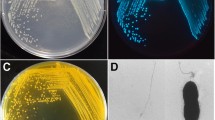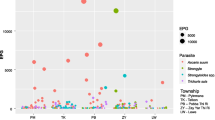Abstract
Wild collected orange-spotted grouper were domesticated in Recirculating Aquaculture Systems (RAS) and sea cages for fish breeding. While breeding, viral nervous necrosis (VNN) infection was observed in both the systems after 18 months of domestication. Out of 50 domesticated broodfish used in the study, 11 (22%) fishes were found positive for VNN examined by reverse transcriptase polymerase chain reaction (RT-PCR) method. Quantitative real-time PCR (qPCR) study also confirmed the presence of VNN in the suspected fish, and detectable amount of virus copy number was observed in the brain, optic nerve, caudal fin, muscle, and gills. Analysis of the isolated viral gene sequence from the fish was closely related to the red-spotted grouper nervous necrosis virus (RGNNV) genotype and suggests that the isolates are probably endemic to Indian coast. The study also indicated that the sub-adults of orange-spotted grouper infected in the wild and remained as carrier during domestication and subsequently disease outbreak has occurred when water temperature was increased in culture environment. This is the first report on VNN in orange-spotted grouper broodstock from India. The results of the study illustrated that large population of the wild marine fishes are sub-clinically infected with betanodavirus and therefore, early detection of the disease should be adopted as best management practices in breeding for sustainable aquaculture development of the species.




Similar content being viewed by others

References
Agnihotri K, Pease B, Chong R (2016) Molecular analysis of RNA1 and RNA2 sequences from a betanodavirus isolated from giant grouper (Epinephelus lanceolatus) in Australia. Virol Rep 6:25–31. https://doi.org/10.1016/j.virep.2016.05.001
Azad IS, Shekhar MS, Thirunavukkarasu AR, Poornima M, Kailasam M, Rajan JJS, Ali SA, Mathew Abraham SA, Ravichandran P (2005) Nodavirus infection causes mass mortalities in hatchery produced larvae of Asian sea bass, Lates calcarifer: first report from India. Dis Aquat Org 63:113–118. https://doi.org/10.3354/dao063113
Binesh CP, Renuka K, Malaichami N, Greeshma C (2013) First report of viral nervousnecrosis-induced mass mortality in hatchery-reared larvae of clownfish, Amphiprion sebae Bleeker. J Fish Dis 36:1017–1020. https://doi.org/10.1111/jfd.12001
Burns KM, Restrepo V (2002) Survival of reef fish after rapid depressurization: field and laboratory studies. Am Fish Soc Symp 30:148–151. https://doi.org/10.1016/j.fishres.2008.12.003
Butcher PA, Broadhurst MK, Hall KC, Cullis BR, Raidal SR (2012) Assessing barotrauma among angled snapper (Pagrus auratus) and the utility of release methods. Fish Res 127:49–55 https://doi.org/10.1016/j.fishres.2012.04.013
Chi SC, Lo BJ, Lin SC (2001) Characterization of grouper nervous necrosis virus (GNNV). J Fish Dis 24:3–13
Frerichs GN, Tweedie A, Starkey WG, Richards RH (2000) Temperature, pH and electrolyte sensitivity, and heat, UV and disinfectant inactivation of sea bass (Dicentrarchus labrax) neuropathy nodavirus. Aquaculture 185:13–24
Fukuda Y, Nguyen HD, Furuhashi M, Nakai T (1996) Mass mortality of cultured seven-band grouper, Epinephelus septemfasciatus, associated with viral nervous necrosis. Fish Pathol 31:165–170. https://doi.org/10.3147/jsfp.31.165
Furusawa R, Okinaka Y, Toshihiro N (2006) Betanodavirus infection in the freshwater model fish medaka (Oryzias latipes). J Gen Virol 87:2333–2339. https://doi.org/10.1099/vir.0.81761-0
Gomez DK, Baeck GW, Kim JH, Choresca CH Jr, Park SC (2008) Molecular detection of betanodavirus in wild marine fish populations in Korea. J Vet Diagn Investig 20:38–44
Gomez DK, Sato J, Mushiake K, Isshiki T, Okinaka Y, Nakai T (2004) PCR-based detection of betanodaviruses from cultured and wild marine fish with no clinical signs. J Fish Dis 27:603–608. https://doi.org/10.1111/j.1365-2761.2004.00577.x
Gopakumar G, Nazar AK, Tamilmani G, Sakthivel M, Kalidas C, Ramamoorthy N, Palanichamy S, Ashok MV, Rao KS, Rao GS (2011) Broodstock development and controlled breeding of cobia Rachycentron canadum (Linnaeus 1766) from Indian seas. Ind J Fish 58(4):27–32
Jaramillo D, Hick P, Deece K, Tweedie A, Kirkland P, Arzey E (2016) Comparison of ELISA formats for detection of antibodies specific for nervous necrosis virus (Betanodavirus) in the serum of immunized barramundi Lates calcarifer and Australian bass Macquaria novemaculeata. Aquaculture 451:33–38
Jithendran KP, Vijayan KK, Alavandi SV, Kailasam M (2005) Benedenia epinepheli (Yamaguti, 1937), a monogenean parasite in captive broodstock of grouper, Epinephelus tauvina (Forskal). Asian Fish Sci 18(1):121–126. https://doi.org/10.1016/j.aquaculture.2015.08.015
Kiryu I, De la Pena LD, Maeno Y (2007) Distribution of nervous necrosis virus in orange spotted grouper Epinephelus coioides with asymptomatic infection. Fish pathology 42(3):163–165
Kuo HC, Wang TY, Chen PP, Chen YM, Chuang HC, Chen TY (2011) Real-time quantitative PCR assay for monitoring of nervous necrosis virus infection in grouper aquaculture. J Clin Microbiol 49(3):1090–1096. https://doi.org/10.1128/JCM.01016-10
Leong TS, Wong SY (1988) A comparative study of the parasite fauna of wild and cultured grouper (Epinephelus malabaricus Bloch & Schneider) in Malaysia. Aquaculture 68:203–207. https://doi.org/10.1016/0044-8486(88)90353-5
Mustafa S, Hajini MH, Senoo S, Seok Kian AY (2016) Conditioning of broodstock of tiger grouper, Epinephelus fuscoguttatus in a recirculating aquaculture system. Aquac Rep 2:117–119. https://doi.org/10.1016/j.aqrep.2015.09.004
Nadia C, Amdouni F (2017) Nodaviruses in wild fish population collected around aquaculture cage sites from coastal areas of Tunisia fish. Aqua J 8(3):209. https://doi.org/10.4172/2150-3508.1000209
Nguyen HD, Nakai T, Muroga K (1998) Progression of striped jack nervous necrosis virus (SJNNV) infection in naturally and experimentally infected striped jack Pseudocaranx dentex larvae. Dis Aquat Org 24:99–105
Oh MJ, Jung SJ, Kim SR, Rajendran KV, Kim YJ, Choi TJ, Kim HR, Kim JD (2002) A fish nodavirus associated with mass mortality in hatchery reared red drum, Sciaenops ocellatus. Aquaculture 211:1–7
Overgard AC, Nerland AH, Fiksdal IU, Patel S (2012) Atlantic halibut experimentally infected with nodavirus shows increased levels of T-cell marker and IFN transcripts. Dev Comp Immunol 37:139–150
Pomeroy R (2002) The status of grouper culture in Southeast Asia. SPC Live Reef Fish Inform Bull 10:22–26
Ranjan R, Megarajan S, Xavier B, Dash B, Ghosh S, Menon M, Edward LL (2017) Conditioning, maturation and year-round natural spawning of orange-spotted grouper, Epinephelus coioides (Hamilton, 1822), in recirculating aquaculture system. Aquac Res 48(12):5864–5873. https://doi.org/10.1111/are.13409
Ranjan R, Xavier B, Santhosh B, Sekar M, Ghosh S (2018) Copepod parasite Lepeophtheirus kabatai (Ho & Dojiri, 1977) infestation in orange spotted grouper, Epinephelus coioides (Hamilton, 1822) and its control in captivity. Indian J Fish 65(3):122–125. https://doi.org/10.21077/ijf.2018.65.3.76423-17
Sekar M, Ranjan R, Xavier B, Edward LL, Behera PR, Ghosh S (2014) Barotrauma in orange spotted grouper, (Epinephelus coioides) and it’s mitigation measures. In: Book of abstracts of 10th Indian Fisheries and Aquaculture Forum, NBFGR, Lucknow, 12–15 November 2014
Sekar M, Ranjan R, Xavier B, Edward LL, Dash B, Ghosh S (2015) Grouper culture-a new venture for Indian aqua farmers. Fishing Chimes 35(9):46–49
Simoes JM, Duarte Ine SG, Fonseca PJ, Turner GF (2008) Courtship and agonistic sounds by the cichlid fish Pseudotropheus zebra. J Acoust Soc Am 124:1332–1338. https://doi.org/10.1121/1.2945712
Sharma SRK, Pradeep MA, Dube PN, Kumar TVA, Kumar R, Swaminathan TR (2018) Betanodavirus-associated mortality in Asian seabass (Lates calcarifer, Bloch) cultured in indoor tanks and sea cages. Aquac Int 27(1):279–286
Shetty M, Maiti B, Shivakumar SK, Venugopal MN, Karunasagar I (2012) Betanodavirus of marine and freshwater fish: distribution, genomic organization, diagnosis and control measures. Indian J Virol 23:114–123. https://doi.org/10.1007/s13337-012-0088-x
Toffan A, Pascoli F, Pretto T, Panzarin V, Abbadi M, Buratin A, Quartesan R, Gijon D, Oadros F (2017) Viral nervous necrosis in gilthead sea bream (Sparus aurata) caused by reassortant betanodavirus RGNNV/SJNNV: an emerging threat for Mediterranean aquaculture. Sci Rep 7(46755). https://doi.org/10.1038/srep46755
Yong CY, Yeap SK, Omar AR, Tan WS (2017) Advances in the study of nodavirus. Peer J 5:e3841. https://doi.org/10.7717/peerj.3841
Whelan JA, Russell NB, Whelan MA (2003) A method for absolute quantification of cDNA using realtime PCR. J Immunol Methods 278(1–2):261–269
Zhang Q, Liu Q, Liu S, Yang H, Liu S, Zhu L, Yang B, Jin J, Ding L, Wang X, Liang Y, Wang Q, Huang J (2014) A new nodavirus is associated with covert mortality disease of shrimp. J Gen Virol 95:2700–2709. https://doi.org/10.1099/vir.0.070078-0
Acknowledgments
The authors would like to thank Mr. Loveson L. Edward for productive input during the study.
Funding
The authors are grateful to the Director, ICAR-CMFRI, for providing financial support to carry out this work.
Author information
Authors and Affiliations
Contributions
There are seven authors who have contributed to accomplish the work with various levels. Sekar Megarajan has major contribution in planning and execution of the work. Ritesh Ranjan, Biji Xavier, Narasimhulu Sadu, and Chinnibabu Bathina had involved in sample examinations and further lab activities. Shubhadeep Ghosh and Achamveettil Gopalakrishnan had involved in overall management of the research program.
Corresponding author
Ethics declarations
Conflict of interest
This study was conducted under one of the institutional research project work under the major research area. Therefore, there is no separate fund allotted to carry out this particular research work. All the institutional research project work was funded by Indian Council of Agricultural Research, New Delhi. The authors declare that they have no conflict of interest.
Research involving animals
The study was carried out on vertebrate fish used our breeding program. During the study, samples were collected from both the dead and live fishes. When live fishes were used the fishes were properly anesthetized and then used for the sample collection and related research work. However, the established protocols for examining the dead and live fish by the institute were followed during the examination of the fish. Therefore, this article does not contain any studies that are against to ethics.
Additional information
Publisher’s note
Springer Nature remains neutral with regard to jurisdictional claims in published maps and institutional affiliations.
Rights and permissions
About this article
Cite this article
Megarajan, S., Ranjan, R., Xavier, B. et al. Molecular detection of betanodavirus in orange-spotted grouper (Epinephelus coioides) broodstock maintained in recirculating aquaculture systems and sea cages. Aquacult Int 28, 349–362 (2020). https://doi.org/10.1007/s10499-019-00466-3
Received:
Accepted:
Published:
Issue Date:
DOI: https://doi.org/10.1007/s10499-019-00466-3



